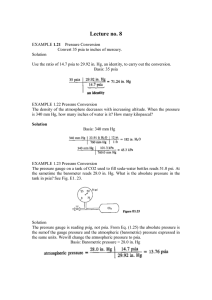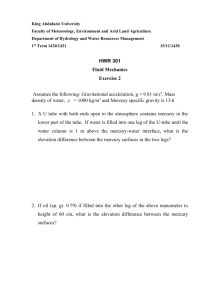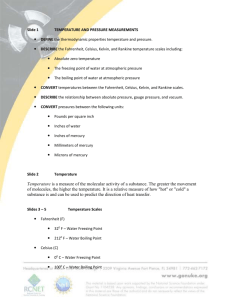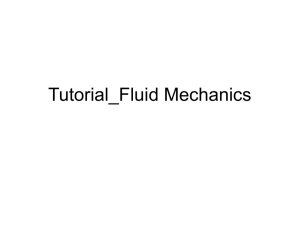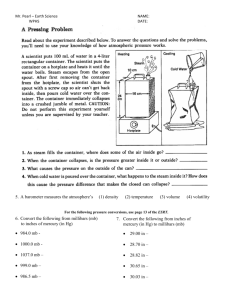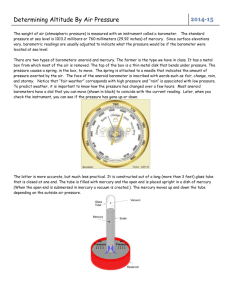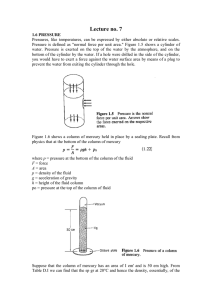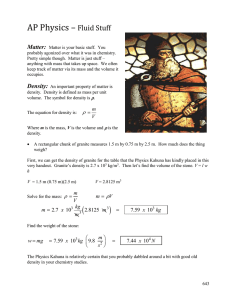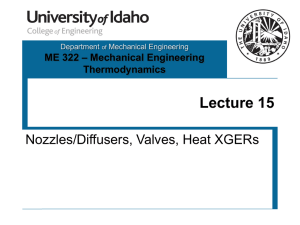pressure
advertisement
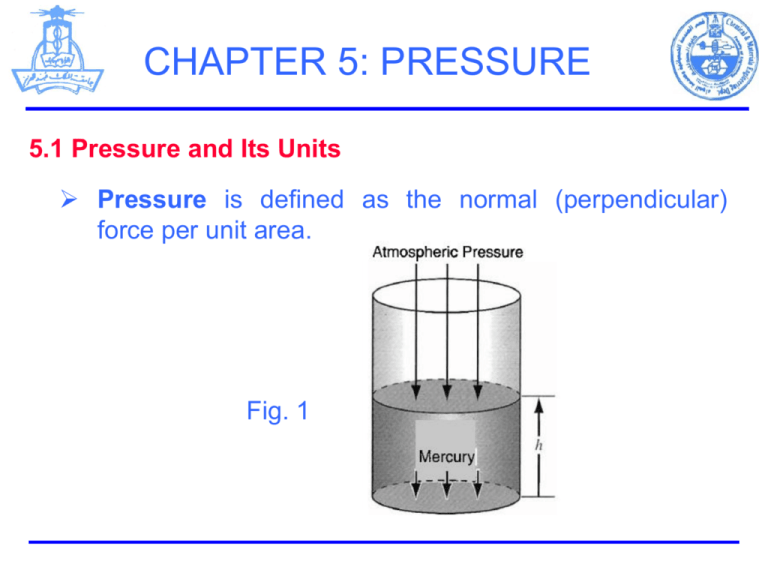
CHAPTER 5: PRESSURE 5.1 Pressure and Its Units Pressure is defined as the normal (perpendicular) force per unit area. Fig. 1 CHAPTER 5: PRESSURE The pressure at the bottom of the static (nonmoving) column of mercury exerted on the sealing plate is: F p = - = ρgh + po A where p = pressure at the bottom of the column of the fluid F = force A = area ρ = density of fluid g = acceleration of gravity h = height of the fluid column po = pressure at the top of the column of fluid In the SI system the force is expressed in newtons, and area in square meters; then the pressure is N/m2 or pascal (Pa). CHAPTER 5: PRESSURE Example: Suppose that the cylinder of fluid in Figure (1) is a column of mercury that has an area of 1 cm2 and is 50 cm high. The density of the Hg is 13.55 g/cm3. What is the pressure on the section of the plate covered by the mercury. ρ g h A C= Conversion factor CHAPTER 5: PRESSURE 5.2 Measurement of Pressure Pressure can be expressed using either an absolute or a relative scale. Whether relative or absolute pressure is measured in a pressure measuring device depends on the nature of the instrument used to make the measurements (a) Open- end manometer (a) Closed- end manometer CHAPTER 5: PRESSURE Water and mercury are commonly used indicating fluids for manometers; the readings thus can be expressed in "inches or cm of water," "inches or cm of mercury,“ and so on. gauge pressure + barometric pressure = absolute pressure The standard atmosphere is defined as the pressure (in a standard gravitational field) equivalent to 1 atm or 760 mm Hg at 0°C or other equivalent value. Atmospheric pressure is variable and must be obtained from a barometric measurement each time you need it. CHAPTER 5: PRESSURE The standard atmosphere is equal to: 1.000 atmospheres (atm) 33.91 feet of water (ft H20) 14.7 (14.696, more exactly) pounds (force) per square inch absolute (psia) 29.92 (29.921, more exactly) inches of mercury (in. Hg) 760.0 millimeters of mercury (mm Hg) 1.013 x lo5 pascal (Pa) or newtons per square meter (N/m2); or 101.3 kPa CHAPTER 5: PRESSURE Bourdon gauge pressure-measuring devices CHAPTER 5: PRESSURE when you measure the pressure in "inches of mercury vacuum," you are reversing the usual direction of measurement, and measure from the atmospheric pressure downward to zero absolute pressure. Inches Hg vacuum = barometric pressure - absolute pressure. or Vacuum pressure = barometric pressure - absolute pressure. CHAPTER 5: PRESSURE Example: What is the equivalent pressure to 60 Gpa in: (a) atmospheres (b) psia (c) inches of Hg (d) mm of Hg Solution: Basis: 60 GPa CHAPTER 5: PRESSURE Example: The pressure gauge on a tank of CO2 used to fill soda-water bottles reads 51.0 psi. At the same time the barometer reads 28.0 in. Hg. What is the absolute pressure in the tank in psia. CHAPTER 5: PRESSURE Solution: The absolute pressure in the tank is: 5 1.0 psia + 13.76 psia = 64.8 psia CHAPTER 5: PRESSURE 5.3 Differential Pressure Measurements Pressure difference The difference between the pressure at one point and another, usually as measured by an instrument. In case of ρ1= ρ3 = ρ barometer CHAPTER 5: PRESSURE EXAMPLE: In measuring the flow of fluid in a pipeline as shown in the next figure, a differential manometer was used to determine the pressure difference across the orifice plate. The flow rate was to be calibrated with the observed pressure drop (difference). Calculate the pressure drop p1-p2 in pascals. CHAPTER 5: PRESSURE Solution:
